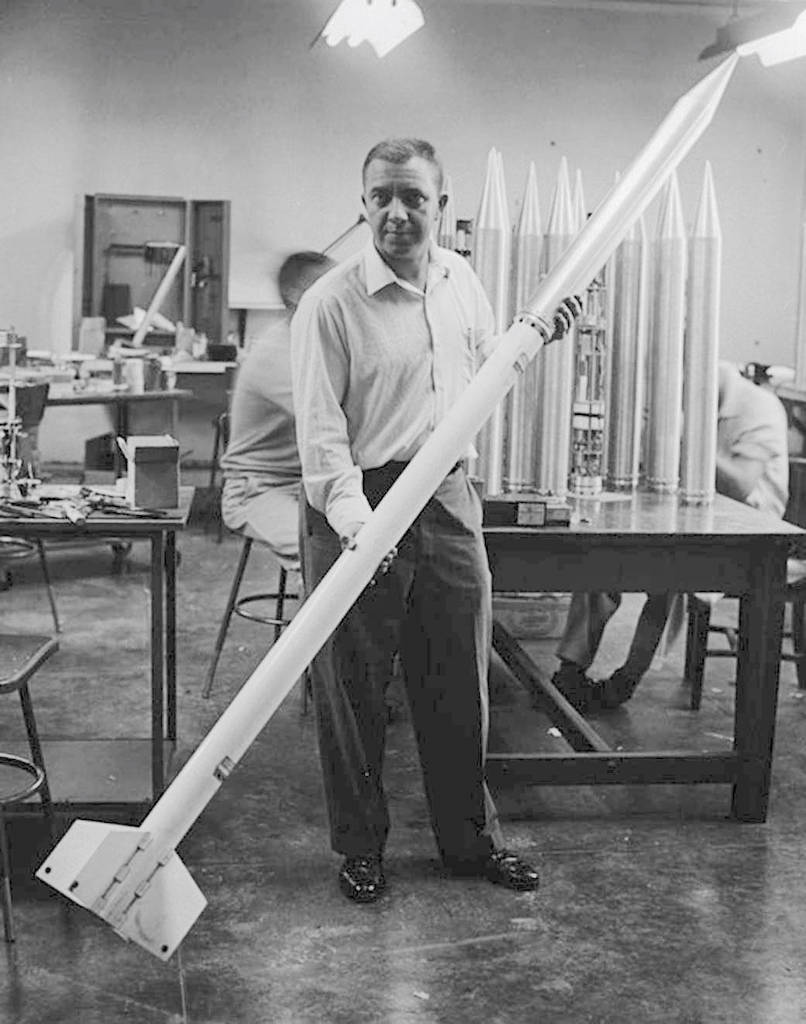
Dr. James Van Allen utilized high altitude balloons and rockets — known as “rockoons” — to explore radiation levels in space. This is Van Allen in his laboratory. Photo courtesy of the F.W. Kent Collection, University of Iowa Special Collections
July/Aug 2022 (Volume 14, Issue 4)
By Timothy Walch
“Ad astra” — a Latin phrase meaning “to the stars” — might well have been the motto of Dr. James Van Allen, longtime professor of physics at the University of Iowa who became known as the modern day “Father of Space Science.” Over the course of more than seven decades, Van Allen discovered radiation belts that now bear his name and developed a way to map the solar system based on solar winds, solar storms and cosmic rays. His was a journey of eight billion miles and counting.
Iowa native Van Allen was born near Mount Pleasant on Sept. 7, 1914. He lived on a farm a few miles outside of town, the second of four children born to Alfred and Alma Van Allen.
It was a good Dutch family, independent and industrious. If there was a task that needed to be done, one of the boys would shoulder the burden. If something was broken, they rose to the challenge. The Van Allen boys were practical, mechanical and curious.
What made the Van Allen brothers different were their intellectual skills. James Van Allen, for example, was an avid reader of magazines such as “Popular Science” and “Popular Mechanics.” He was captivated by science and engineering, so he made it his hobby to figure out how things worked.
The Mount Pleasant school system was his first laboratory. After mastering the range of course work in each grade, Van Allen focused on science — particularly electrical devices. In a memoir published late in life, Van Allen recalled that as a boy he built a Tesla coil that emitted long sparks and made his hair stand on end. That precocious achievement horrified his mother!
There’s no question that young Van Allen had a passion for exploration at an early age. His school notebooks are filled with stories and notes about Christopher Columbus, Ferdinand Magellan and Leif Ericsson. In fact, Van Allen memorized long lists of explorers and their conquests.
Van Allen credited a teacher named C.A. Cottrell with stimulating his interest in science. Also of note was the fact that he developed companion skills in wood and metal working which helped him craft devices for his experiments.
In his senior year of high school, Van Allen got excited by scientific experimentation that focused on mass, velocity and energy. His teachers gave him wide latitude to pursue his own path. “Just close the door when you leave,” they told him.
After high school, Van Allen moved across town to Iowa Wesleyan College. It was there in the summer of 1932, that Van Allen met physics professor Thomas C. Poulter who introduced him to geophysics. He remembered that Poulter was “one of the most inspiring experimentalists that I have ever known.”
Poulter collaborated with Admiral Richard E. Byrd as the chief scientist on Byrd’s second expedition to Antarctica. As part of the preparations, Poulter employed Van Allen to assess a sensitive field magnetometer on loan from the Carnegie Institution. It fascinated Van Allen and became a key device in his last two years at Iowa Wesleyan College.
Graduation in 1935 brought new opportunities. Eschewing offers outside his native state, Van Allen pursued an advanced degree in physics at the University of Iowa. He collaborated closely with Professor Edward Tyndall and received his master’s degree in 1936.
His thesis led to a fellowship in nuclear physics at the Carnegie Institution in Washington, D.C. It was an experience that expanded his research and sharpened his interest in geomagnetism and the physics of the upper atmosphere. His interest in space started at Iowa Wesleyan, further developed at the University of Iowa, and matured at the Carnegie Institution.
Van Allen returned to Iowa City in 1937 to pursue a doctorate in physics. Working with Professor Alexander Ellett, he concentrated on nuclear physics and received his Ph.D. in August of 1939. His exceptional intellect led to a research fellowship at the Carnegie Institution in 1940. It was there that Van Allen shaped his understanding of solar-terrestrial physics as a field of research.
TO READ THE ENTIRE STORY AND OTHER FASCINATING STORIES ABOUT IOWA HISTORY, subscribe to Iowa History Journal.
